You might notice that these films are now a little out of order. That’s because I had not originally intended to include the post-war anthology films in this Disney Watch-Watch, since all five are more collections of cartoons than actual shorts.
And then I got a number of emails proving that, if nothing else, a number of you have very passionate feelings about Saludos Amigos and Melody Time—specifically, the bumblebee cartoon in Melody Time. And then I remembered that I have one or two somewhat less passionate feelings about Disney’s recent edits to Melody Time. So. Er. Here we go with the anthology films, starting out with arguably the worst of the lot, Saludos Amigos (1942). Which at least has the bonus of being slightly on topic this week, given that portions of it are set in Rio de Janeiro.
Saludos Amigos and its followup film The Three Caballeros marked a distinct new phase in Disney history, where Disney found itself hired by the United States government for a very specific purpose: in this case, a goodwill tour to South America. Some South American countries had either loose ties or seemingly friendly relationships with the Nazi regime, raising concerns in Washington, DC. Mickey Mouse and Donald Duck were very popular with South American audiences, and the State Department hoped that a little bit of Disney magic might encourage South American countries to either join the Allied side or stay neutral in the upcoming conflict. They also agreed to help subsidize the cost of four cartoon shorts.
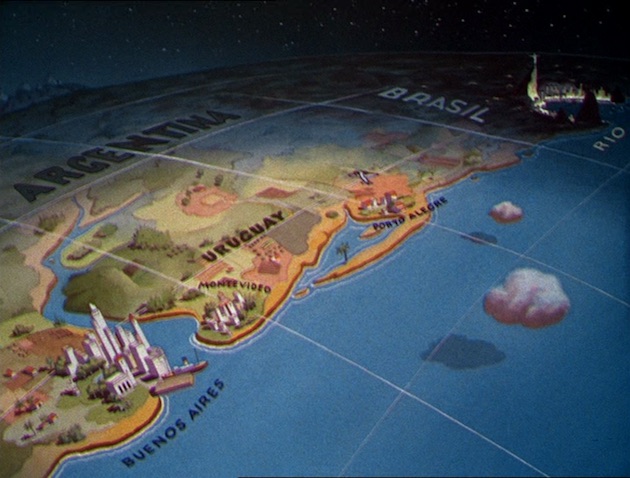
Walt Disney leapt at the offer. His studio was in dire financial state after the closing of European theatres and the resulting loss of a high percentage of his revenue, the box office failures of the lavishly animated and thus expensive Pinocchio and Fantasia, the current costs for Bambi (then well over budget), the refusal of Bank of America to extend new loans, and the opening of a new animation studio building—one his animators didn’t like. To add to the issues, many of his deeply unhappy artists had gone on strike, putting the production of Bambi and Dumbo into severe jeopardy. Revenue from any source was welcome just then—plus, the goodwill tour had the chance of inspiring not just the four subsidized shorts, but other cartoon shorts which might help carry the studio over for the next few years.
As it turned out, the tour did just that—inspiring cartoons that would later be bundled into Saludos Amigos and The Three Caballeros, some of which were also separately released as cartoon shorts or later inserted into various Disney classic DVD collections in slightly different edited versions. And, with Walt Disney safely out of the country and not adding his opinion on negotiations, the labor strike was successfully ended. In that, at least, the tour was a success—if I can’t speak quite as kindly about the final result.
Speaking of the editing, though, to really see Saludos Amigos these days, you actually need to see two films—Saludos Amigos and Walt and El Grupo, which contains the original, unedited version of the third short, El Gaucho Goofy. (The unedited cartoon is also available in an unauthorized, low quality YouTube version.) Done largely to appease fans who wanted the original cartoon back, this turned out to be a great example of Disney’s ability to exploit their assets with multiple releases.
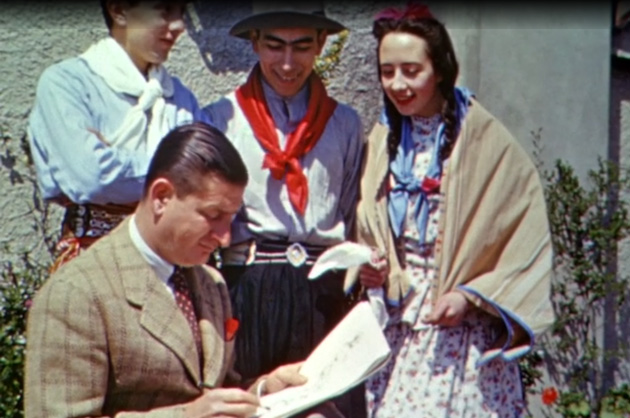
Anyway. The film’s opening narration bypasses the entire anti-Nazi point of the tour, instead cheerfully announcing that we’re about to see something unusual—artists and composers boarding a plane to head down to—gasp!—SOUTH AMERICA! This also helps serve as a warning to viewers that Saludos Amigos is not going to be a standard Disney film, but rather a mix of live action footage and animation meant to showcase the culture and (sorta) the geography of South America, as seen through the eyes of Disney artists. Off everybody flies in a little cartoon airplane to Brazil. A side comment here reminds us that in those days, yes, it did take three days to fly from Los Angeles to Rio de Janeiro. The plane then goes to the Argentine and out across the pampas, sending little animated cows skittering away in terror, before heading to Cordoba, where the group divided, splitting into two little animated airplanes, some heading to Chile, others to Peru.
At this point, thanks to the convenient presence of Walt Disney’s 16mm camera, the film slides back into live action footage of Peru, focusing on Lake Titacaca and Peruvian marketplaces. This is vaguely interesting in a poorly filmed National Geographic special kinda way, but before viewers can get too restless, Donald Duck shows up, as an American tourist, as famous animated ducks tend to do, shifting us from travelogue to generally silly cartoon—if one that supposedly is teaching us a little bit about how to train llamas, more or less following the format of the Goofy “How To” cartoons, something the studio had just started playing with, except starring Donald Duck.
It’s not a great cartoon, either as a “How To” cartoon or as a Donald Duck cartoon, even with the moments where Donald Duck is attempting to train and guide a llama with a flute, and the moment where the narrator calmly explains that when travelling in Peru and dealing with llamas, you should never lose your temper—to Donald Duck, of all ducks. Naturally, Donald Duck is tied up and dangling from a suspension bridge at the time. I can’t be sure if the short is attempting to make a pointed comment about the often awful behavior of American tourists (not just in Peru) or the issue of Disney tourist artists hoping to make a buck or two from Peruvian culture. Or it’s just Donald Duck.
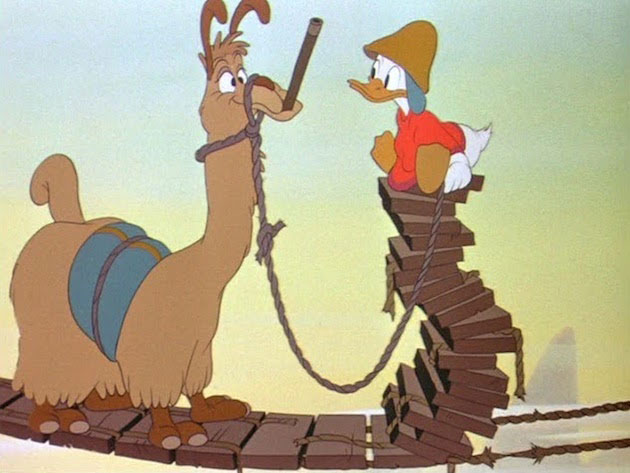
Walt Disney’s camera did not make it to Chile, so instead of images of Chile, the live action sections show images of Disney artists sitting on planes, drawing on planes, getting inspired by planes, and finally creating concept art for a cartoon about planes, making me wonder if anyone ever got off the plane, or if, after several days of omg wow like Rio de Janeiro and Buenos Aires actually have skyscrapers and dress in contemporary clothing crap this is SO not the “local color” or the exotic animals we were looking for let’s go find some, ooh, HERE we go, llamas! Dancing gauchos! The samba! THAT’s more like it! the exhausted artists were just like, yeah, airport’s good, thanks.
Apart from planes, this section does give us a brief idea of how Disney moved from concept art (sketches of planes) to actual art (the cartoon plane), before shifting into the fairly pedestrian little short. Pedro lives with Papa Plane and Mama Plane and has to do boring things like go to school and study plane anatomy. Cue a terrible gag of a plane skeleton composed of bones, which has the unfortunate side effect of giving a rather misleading impression of airplane engineering, which is to say, so much for education.
But moving on. A sad day hits: Papa Plane is sick, and Mama Plane can’t stand the altitude because she has high oil pressure, making me wonder both who on the Disney staff approved that joke and how on earth she had managed to fly before this, but it doesn’t matter, because someone has to go get the mail and make sure that all of those critical messages make it, so little Pedro is off to fly, fly, fly, only to get attacked by a condor and a mountain and—tragically—even the narrator, leaving everyone certain that the little plane is dead and crash land, saving the mail, which turns out to just be an unimportant postcard HA HA LOOK WHAT YOU ALMOST DIED FOR.
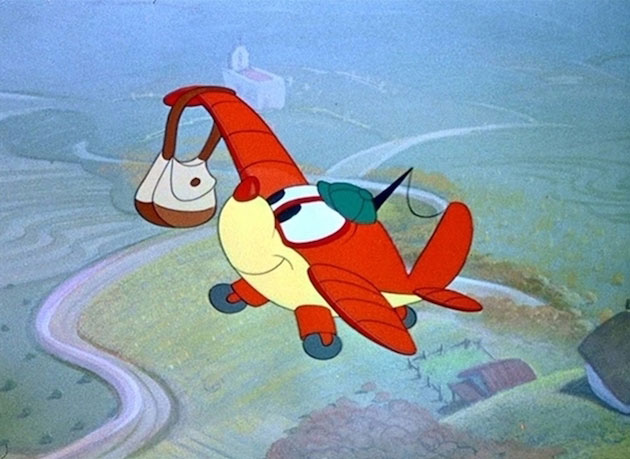
The short isn’t completely without references to Chile—cities, towns, and the Andes mountains get a mention, and the labels are in Spanish. And the story itself—a young protagonist struggling to complete his duty—is typical Disney. But something feels slightly off about that ending, with its implication that while Disney artists are using planes for inspiration, people in Chile are just using—and endangering—little planes to send pointless postcards, not to mention the implication that when you fly off to risk your life, thinking that you are fulfilling your duty, you might well be risking it for nothing. Sure, the risk comes in part from one or two bad decisions made by Pedro, but given the context of the entire goodwill trip, it’s hard to escape the “Stay home, kid!” message. At least one Chilean viewer, cartoonist René Rios Boettiger, found the cartoon not just annoying, but offensive, and created the character of Condorito in response; his comic remains in publication today.
The next section, focused on Argentina, fares better. Sure, as noted, it starts off with the narrator seemingly a bit surprised that Buenos Aires has such amazing things as skyscrapers and actual culture before scurrying off to find something that we shall again call local color, focusing on gauchos and folk dances, as an introduction to the third short, a Goofy “How To” cartoon. Disney had introduced the “How To” shorts starring the not exactly brilliant Goofy, and was still working out the concept, In 1941, when this short was created, the format was still under development, but the major elements are there: Goofy—here a Texas cowboy—shows up in Argentina and tries to learn how to become a gaucho and use a bola, as the narrator provides color commentary. The highlight here is probably a bit where Goofy is asked to do the same scene again, but in slow motion this time, showing just how painful the entire business is, and a clever use of animated film swipes. It’s arguably the most amusing of the shorts; oddly, given this, it’s also the only one of the four shorts that can remotely be called educational.
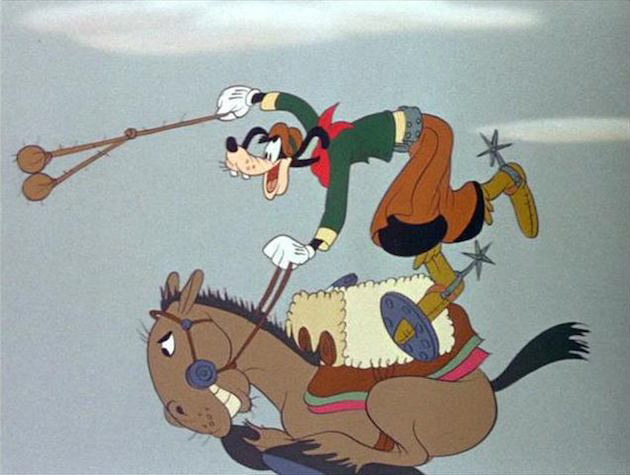
The last section moves to Rio, where the live action narration suddenly gets considerably more enthusiastic, perhaps because this is where the Disney artists seem to have indulged in more than a bit of partying. As with my guess about Disney artists never—or at least rarely—leaving the airport in Chile, I can’t prove that, but that’s definitely the impression left by this section, between the live footage focused on Carnival scenes and a cartoon largely focusing on Donald Duck going partying in Rio di Janeiro and doing the samba with a woman who is very clearly not a duck. Donald, Donald. I sincerely hope that Daisy was conducting a torrid affair with Clark Gable while you were partying down in Rio. (Not to suggest that Clark Gable ever had inappropriate thoughts about ducks, cartoon or otherwise.)
This is also the cartoon that introduced cigar smoking parrot José Carioca and his umbrella to the world. They were immediately popular, and made two more appearances in later films before mostly vanishing from the Disney canon. It’s not clear why, though rumors have persisted that the parrot was never really a favorite of Walt, and animators, knowing this, decided not to pitch shorts starring him. It’s possible that Disney wanted to keep its focus on its prime lineup of Mickey, Donald, and Goofy; it’s also possible that, as the 50s continued, Disney also wanted to move away from characters so heavily associated with smoking. Or that one of the Disney executives simply didn’t like parrots. Whatever the reason, although you can certainly find José Carioca around Walt Disney World, his moment of stardom was brief.
The Brazil cartoon is probably the most innovative—or at least the loveliest to look at—of the four, as Donald Duck and José Carioca move and dance through Rio di Janeiro, providing a nice wrap-up. But despite this nice wrap-up, overall the film never quite works, with its uneasy combination of documentary narrative (the live action footage and, to an extent, the first Donald Duck short and the Goofy short) and humorous shorts, not to mention the gung ho little Pedro cartoon. Saludos Amigos is never quite sure what it is—an educational film, a travelogue, an outreach attempt, or an attempt to showcase its popular Donald Duck and Goofy characters.
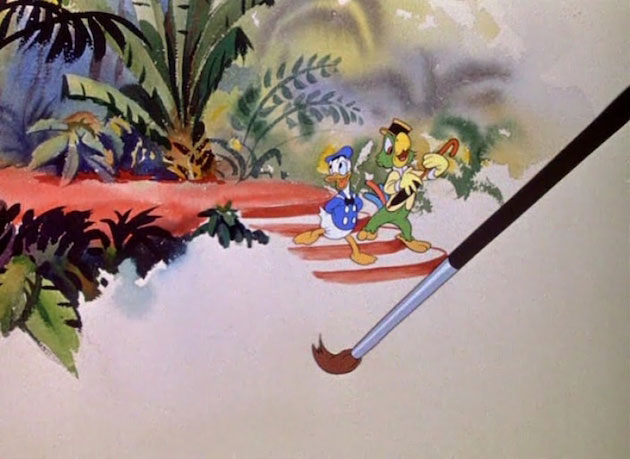
And thus, it tends to fail on all levels. With the very arguable exceptions of the Peru section (where we learn that Peru still has traces of Incan culture, also, llamas) and the Argentinian section (where we kinda learn about gauchos, but mostly just watch Goofy get injured), the film is far too shallow and brief to teach anything. The travelogue bits are severely limited both by the limitations of Walt Disney’s camera and by the decision to see Peru and Rio di Janeiro through the perspective of an angry, dancing duck.
It fails, too, as unified film in other respects. The live action bits—while fascinating in their own way as glimpses into Disney history and artists at work—generally feel like distractions from the cartoons. And with the exception of Donald’s tussle with the llama on a suspension bridge and one or two clever moments in the Goofy cartoon and the second Donald Duck short, the cartoons themselves are mostly forgettable —probably why, even by the standards of the generally forgotten anthology films, this one tends to be really forgotten. It’s all just, well, rather dull.
Saludos Amigos also had the unenviable fate of getting released after the U.S. entry into World War II, in 1942 in Brazil, and early 1943 in the United States, after Bambi had badly stumbled at the box office. Saludos Amigos earned back its initial costs, but not much more than that. Still, since the four shorts had been sponsored to begin with, the film and war training films that Disney was rapidly pushing through the studio were just enough to pay costs and convince Bank of America not to call in full loan payments quite yet. Two of the shorts—the initial Donald Duck short and the Goofy short—were later repackaged as separate shorts, helping bring in still more revenue. The film was one of two inspirations for the water ride at Epcot’s Mexico pavilion (my advice: skip the ride and head straight to the really amazing tequila bar), and Disney continues to sell merchandise featuring Donald Duck in various South American costumes.

If it was not quite enough to encourage Disney do do another semi educational/goodwill/travelogue/animation film ever again, it was enough to encourage Disney to create a follow up film.
The Three Caballeros, coming up next.
Mari Ness lives in central Florida.










